List of oldest buildings and structures in Halifax, Nova Scotia
This is a list of oldest buildings and structures in Halifax, Canada that were constructed before 1920.
1750-1799
| Place | Address | Coordinates | Description | Image | Date |
|---|---|---|---|---|---|
| St. Paul's Anglican Church | Grand Parade (Halifax) | Oldest building in Halifax (1750); Early Palladian church; second and oldest surviving Protestant church in Canada |  |
1750 | |
| Little Dutch (Deutsch) Church | Brunswick Street, Halifax | Second oldest building in Halifax – Oldest known surviving church in Canada associated with the German-Canadian community, 1756–60 |  |
1756 | |
| Sambro Island Light | Sambro, Nova Scotia | Oldest lighthouse in North America |  |
1758 | |
| The Carleton | Argyle Street, Halifax | Apart from two churches, oldest building in HRM | 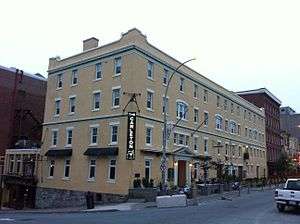 |
1760 | |
| Morris House (Halifax) | Creighton St. Halifax | oldest wooden home in HRM | 1764 | ||
| Scott Manor House | Fort Sackville Dr., Bedford | Built on the land of Captain George Scott adjacent to Fort Sackville | 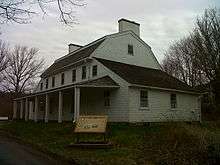 |
1770 | |
| Quaker Whaler House | Ochterloney Street, Dartmouth | Nantucket architecture | 1785 | ||
| Privateer's Warehouse, Historic Properties | Commercial grouping reflecting Halifax's 19th century development | 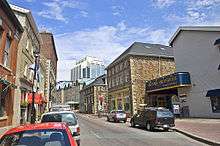 |
c. 1790 | ||
| York Redoubt | Major seaward defences of Halifax Harbour until World War II |  |
1793 | ||
| Prince of Wales Tower | Point Pleasant Park | Oldest Martello Tower in North America | 1796 | ||
| Alex McLean House | Hollis St., Halifax | 1799 |
1800-1849
| Place | Address | Coordinates | Description | Image | Date |
|---|---|---|---|---|---|
| St. George's Anglican Church / Round Church | Unique Palladian style round church, 1800–12 | .jpg) |
1800 | ||
| Halifax Town Clock | 44°38′51″N 63°34′49″W / 44.64750°N 63.58028°W |
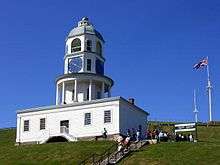 |
1803 | ||
| Government House | Excellent, early, Palladian style vice-regal residence | .jpg) |
1805 | ||
| Royal Artillery Park Officers' Mess | 1575 Queen Street | Oldest active military mess in Canada | 1816 | ||
| Akins House [1] | 44°39′12″N 63°34′55″W / 44.65333°N 63.58194°W |
A one-and-a-half-storey wood-shingled house originally built for Thomas Beamish Akins, surviving virtually in its original condition; one of the few remaining early 19th-century houses in Halifax and one of the oldest houses in the city | c.1815 | ||
| Province House | Oldest legislative seat in Canada and site of the country's first responsible government | .jpg) |
1819 | ||
| Admiralty House [2] | 44°39′34″N 63°35′34″W / 44.65944°N 63.59278°W |
An austere two-storey stone mansion set within the Stadacona site of CFB Halifax which served as the home of Commander-in-Chief of the Royal Navy’s North American station from 1819 until 1904 |  |
1819 | |
| Black-Binney House [3] | 44°38′38″N 63°34′17″W / 44.64389°N 63.57139°W |
A house reflective of the Palladian-inspired residences common during the late 18th and early 19th centuries in Eastern Canada; notable residents include John Black, James Boyle Uniacke and Hibbert Binney | c.1819 | ||
| St. Mary's Basilica, Halifax | Central role in the religious history of Nova Scotia. | |
1820–29 | ||
| Henry House | Common 19th century urban type in local ironstone; residence of Father of Confederation, William A. Henry |  |
1834 | ||
| Acacia Cottage | Built in 1816 on Coburg road across from the Waegwoltic Club, within a grove of acacia trees (hence the name). It was later moved up the hill in 1950 (facing demolition) to South street where it now remains.[4][5] |  |
1816 | ||
1850-1899
| Place | Address | Coordinates | Description | Image | Date |
|---|---|---|---|---|---|
| Halifax Citadel | 44°38′51″N 63°34′49″W / 44.64750°N 63.58028°W |
Restored British masonry fort, constructed between 1828 and 1856. | |
1856 (completed) | |
| Halifax Court House | Italianate court house. | |
1858 | ||
| Cast Iron Façade / Coomb's Old English Shoe Store [6] | 44°38′59″N 63°34′29″W / 44.64972°N 63.57472°W |
A mid-19th-century commercial building with a cast-iron facade; one of the first cast-iron-front structures in Canada and the only building in Halifax known to have a facade composed entirely of cast iron | 1860 | ||
| Fernwood [7] | 44°37′37″N 63°34′55″W / 44.62694°N 63.58194°W |
A house on a large landscaped property; a noted example of a Gothic Revival villa in Canada |  |
1860 | |
| Art Gallery of Nova Scotia | |
1869 (completed) | |||
| Fort Charlotte | 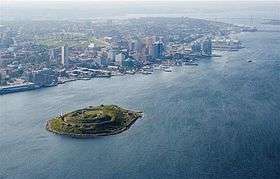 |
1869 (completed) | |||
| Ladies' Seminary | Represents the earliest phase of Women's higher education; | 1878 | |||
| Halifax City Hall | Civic symbol on Grand Parade; Second Empire style | 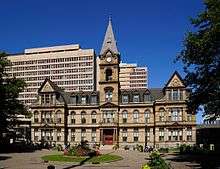 |
1887 | ||
| Cambridge Military Library | Sackville Street | 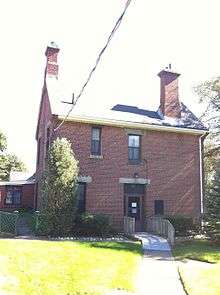 |
1886 | ||
| Jonathan McCully House | Italianate urban residence of politician and Father of Confederation, Jonathan McCully | ||||
| King's College | Site of Anglican college, 1789–1923 | ||||
| Khyber Centre for the Arts AKA The Khyber, and originally The Church of England Institute Building | 1588 Barrington St | Victorian-Gothic building designed by Henry Busch, as overseen by Bishop Hibbert Binning. Name "Khyber" began to be used in the 1970s after the Khyber Cafe that ran on the 1st floor. This building has been utilized for social activities since its construction when it housed a gym, library, lecture hall, and billiards. | 1888 | ||
| Fort McNab [8] | 44°36′0″N 63°31′0″W / 44.60000°N 63.51667°W |
The remnants of defensive works constructed to defend Halifax when it was one of the principal naval stations of the British Empire; reflective of significant changes in defence technology in the late 19th century |  |
1892 (completed) | |
| Halifax Armoury | Large, urban, Romanesque Revival drill hall for the active militia, 1895–99 | |
1899 | ||
1900-1929
| Place | Address | Coordinates | Description | Image | Date |
|---|---|---|---|---|---|
| Cathedral Church of All Saints | 1330 Martello St, Halifax NS B3H 2Z1 (902) 423-6002 | Largest Anglican Cathedral in Canada. Perpendicular NeoGothic Structure, Ralf Adams Cram Architect |  |
1910 | |
| Pier 21 | Highly specialized building type related to early 20th-century Canadian immigration and post war immigration | |
1928 | ||
| Hydrostone District | North End, Halifax – Public housing in Garden Suburb style. |  |
1920s | ||
See also
| Wikimedia Commons has media related to National Historic Sites of Canada in Nova Scotia. |
- History of Nova Scotia
- List of historic places in the Halifax Regional Municipality
- List of National Historic Sites of Canada in Nova Scotia
- List of historic places in Nova Scotia
- List of oldest buildings and structures in Toronto
- History of the Halifax Regional Municipality
- List of oldest buildings in Canada
References
- ↑ Akins House. Canadian Register of Historic Places. Retrieved 25 August 2012.
- ↑ Admiralty House. Canadian Register of Historic Places. Retrieved 22 August 2012.
- ↑ Black-Binney House. Canadian Register of Historic Places. Retrieved 26 August 2012.
- ↑ "The Outside In of 6080 - Spacing Atlantic". Spacing Atlantic. Retrieved 2015-11-27.
- ↑ "Halifax Urban Greenway: Natural History Introduction". halifaxurbangreenway.org. Retrieved 2015-11-27.
- ↑ Cast Iron Façade / Coomb's Old English Shoe Store. Canadian Register of Historic Places. Retrieved 26 August 2012.
- ↑ Fernwood. Canadian Register of Historic Places. Retrieved 30 September 2012.
- ↑ Fort McNab. Canadian Register of Historic Places. Retrieved 2 February 2013.
This article is issued from Wikipedia - version of the 11/27/2015. The text is available under the Creative Commons Attribution/Share Alike but additional terms may apply for the media files.